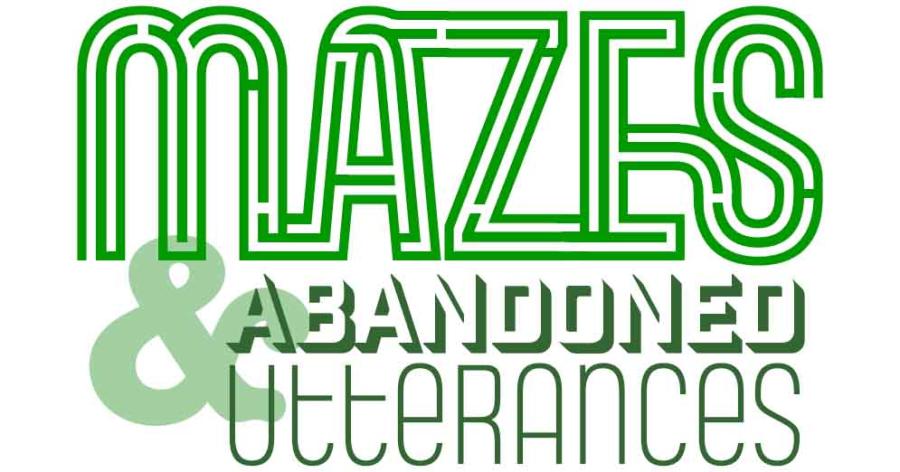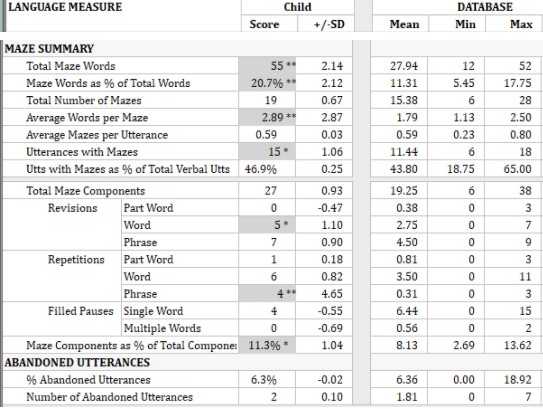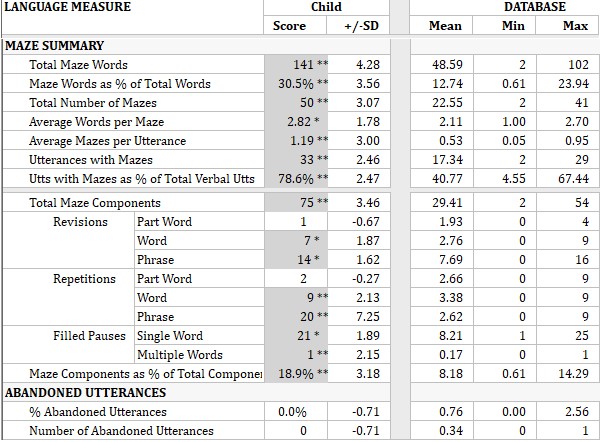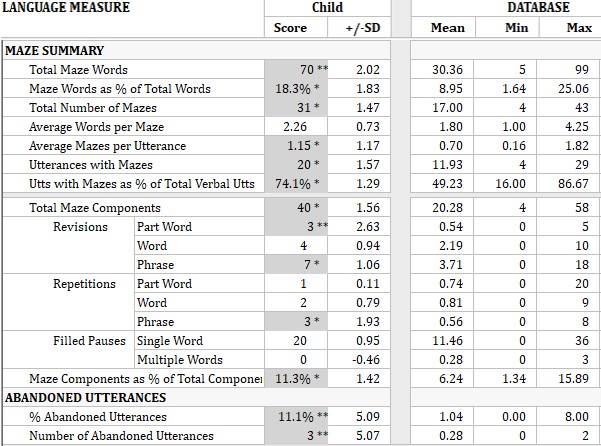
Mazes and Abandoned Utterances: Why They Matter

Mazes and Abandoned Utterances: Why They Matter
Published at: 2021-02-26
You may have noticed that some methods of language sample analysis ask you to include mazes in transcription, while others do not. SALT does ask you to include mazes. Have you ever wondered why? Perhaps you had the sneaking suspicion that, if some protocols exclude mazes, they can’t really be that important. And, after all, including them makes transcription longer and more complex, so there had better be a good reason to include them. Well, let me tell you what you’re missing when you skip mazes. First, a refresher. What is a Maze? Maze:
- A confusing network of intercommunicating paths or passages; labyrinth (Dictionary.com)
- Linguistic nonfluencies (filled pauses, repetitions, revisions, and abandoned utterances) that are not part of the intended message and that detract from its efficient communication (Loban, 1976).
The maze (also known as garbles, word tangles or false starts) is usually defined as a series of words, initial parts of words, or unattached fragments which do not contribute to the meaning in the ongoing flow of language. (Fagan, 1982.)
Until I decided to write this piece, I never gave much thought to Walter Loban’s coining the term “maze.” The multiple-meanings of the word never crossed my mind. Yet, the lightbulb is so bright once you look at it: within a maze, the speaker explores several paths, hits a dead end or two, before eventually emerging successfully (we hope) at the other end. But what happens if the speaker never makes it out of the linguistic labyrinth? The abandoned utterance is considered a “severe maze.” This is where a speaker attempts to, but never finishes their intended utterance. Abandoned utterances can include one or more non-fluencies before ending, or they may start out fluent but abruptly end. In a nutshell, the speaker gives up. Rather than producing more and more tangles, they quit. Take a look at the examples in below. You will notice that, in the abandoned utterances, the speaker never resolves the intended utterance. Typically, in the next utterance there is a topic shift. The succeeding utterance is key in recognizing and supporting the decision to mark the previous as abandoned; the “give up”. In the maze examples, by contrast, the speaker revises, repeats, and/or uses filled (or silent) pauses on the way to the finish line. The topic doesn’t change. The speaker does eventually complete their thought.
Abandoned Utterances: “Unresolved” C (At) I (me*) just > C My favorite is blue. C (And then they fou*) and (then they said) then they both (um)> ; :02 C I forgot. C (Um :03 some of the me*) some of the way/s this can be> C Well everything vary/3s. C And when the horn blowed|blow[EO:blew] they were> C But back before all that happen/ed they> C The warrior bug/s were really circus bug/s. C And then the boy look/ed in the> C The animal bit him. C What I would recommend doing is> C If you don’t have the right equipment, you can/’t finish the job.
Mazes: “Resolved” C But (I want the bl*) I want the red one. C (And then you got) and then you get in the wagon and ride. C And (we we play a) everybody play/3s the same game/s. C And then (she had was they they) they was[EW:were] eat/ing. C It/’s (like[FP] uh like[FP]) in a jar. C Then (he took his um tool) he took (um) a hoister_thing that had like a little clamp on it. C And (the fox said um :02) the fox try/ed to open his mouth. C We have (only) only (those um :07 those um those) those (pa* pa*) frozen pizza/s.
The Theory: What Mazes Tell Us About Our Client’s Language Children with normal language development produce mazes of all types. We know that as linguistic complexity increases, so does the frequency of mazing. We also know that contexts with greater demand, such as narration (vs. conversation), will include more mazes. And, even more importantly, we know that not all maze components are created equal. When it comes to language proficiency, a higher-than-normal frequency of mazes leads the SLP to surmise there is likely a processing problem. That’s a good start, but there is more information to be mined here. Is that processing problem one of word finding or sentence formulation? Here’s where knowing the components of a maze is immensely beneficial. Content mazes, those that include semantic or syntactic revisions (edits), are associated with language formulation. Filled pauses and single or part-word repetitions are more often thought of as stalling behaviors, where the speaker is buying time. It’s not just that there are mazes, our diagnostic outcomes and our therapy goals are informed by how many, and what type of mazes are present. Putting it into Practice: Transcribing and Analyzing Abandoned Utterances Using SALT A language sample is only as useful as the accompanying analysis. So take a moment to think about what you would like to get out of the time you are investing. If the aim is to listen, jot notes and provide anecdotal evidence, there’s no need to transcribe. But for every small step you take in SALT transcription, you make a giant stride in analysis outcomes. (For information on transcript shortcuts in SALT, see this blog post.) There are computerized LSA methods that promote saving time. We won’t say that these approaches are never appropriate. We understand that SLPs can be ridiculously overburdened and short on time. The trade-off is that, beyond MLU, these approaches produce very little data about spoken language. MLU is great for watching new language develop. But as language develops, we also need to see heightened vocabulary, more complex syntax, and fluent production of these maturing domains. If you include mazes in your transcription, SALT will provide a detailed breakdown of the maze components. That’s where a few extra steps in transcription pay off big-time. The clients we evaluate are very often spending time with us because there is more to their story than short sentences with few vocabulary words. Remember the tangles and the give-ups? These features highly impact expression and listener perception. Transcribing and marking repetitions, revisions, and filled pauses creates quantitative data, which, in turn, translates to measurable treatment goals. The data can show our therapy and the client’s efforts have made an impact. We may also learn from the data that we need to change trajectories or try a different treatment method. And the transcription of mazes isn’t difficult, though it does take a bit of extra time. For SALT transcription, just type the mazes inside parentheses. It’s that simple. Type verbatim what the speaker produces. Don’t leave out the “ums” and “ahs”. These productions may be buying the speaker time to retrieve a word or plan an utterance or formulate a response. Don’t leave out the repeated part-words, whole words or phrases. Don’t exclude the edits, the revised productions. Type them in parentheses, and SALT will show you what is prevalent, and what has changed over time. Examples Analyses Below is an example of the maze outcomes from SALT’s Verbal Facility summary (database menu). The speaker, aged 10;11, produced a Narrative Student Selects the Story about the movie Home Alone. Notice the child’s analysis outcomes on the left compared to the outcomes from the typically developing speakers in the SALT Narrative SSS reference database. Gray squares indicate measures that are one or more standard deviations from the mean scores of the database participants.  In this example, the total number of maze words, maze words as a percent of total words, and average words per maze were all more than two standard deviations greater than the database mean, i.e. the child produced more mazes and had more words in his mazes. When you look further at the components of the mazes, you’ll note that phrase repetitions, at 4.65 SD above the mean, had the most significant impact in the language sample. (For more information on interpreting extreme SD scores, see our post on standard deviation.) Here is an example from the transcript:
In this example, the total number of maze words, maze words as a percent of total words, and average words per maze were all more than two standard deviations greater than the database mean, i.e. the child produced more mazes and had more words in his mazes. When you look further at the components of the mazes, you’ll note that phrase repetitions, at 4.65 SD above the mean, had the most significant impact in the language sample. (For more information on interpreting extreme SD scores, see our post on standard deviation.) Here is an example from the transcript:
C And then she says, (it gonna be on for the) "It/'s gonna be on for a little while".
There were also notable word revisions at just over one standard deviation above the mean:
C And (they) she call/ed the police.
From these outcomes, we might be thinking this is a language formulation problem. Always ask yourself: “Are these outcomes representative of what the speaker typically does?” If so, you have excellent data to confirm, to help inform your therapy goals, and to track change over time. Let’s look at another example. These maze outcomes are a student aged 9;1 retelling the story A Porcupine Named Fluffy (Lester, 1986). You’ll note nearly every outcome is one or more standard deviations from the database mean.  This is quite the collection of maze components! When you think about the numbers, almost one third of the words this student produced were maze words. Nearly 80% of the utterances she produced were marked by one or more mazes. These are significant outcomes. When you dig into what is in the mazes, there are revisions, repetitions, and filled pauses. Most notable are word and phrase repetitions, as well as filled pauses. I can’t emphasize this enough: first reflect on the student’s typical production style and what you noted in the language sample. Do they jive? If so, the data and get to work on improving verbal facility! In my experience, abandoned utterances are not as common as other forms of mazes. But they are notable. It’s off-putting to a listener when the end of an expression isn’t reached. We would rather wait out the tangles for the resolution than never get to the end. Verbal facility challenges are also frustrating for the speaker. No one wants to lose their listener! The last example is from a 15-year-old who produced a short expository about tennis.
This is quite the collection of maze components! When you think about the numbers, almost one third of the words this student produced were maze words. Nearly 80% of the utterances she produced were marked by one or more mazes. These are significant outcomes. When you dig into what is in the mazes, there are revisions, repetitions, and filled pauses. Most notable are word and phrase repetitions, as well as filled pauses. I can’t emphasize this enough: first reflect on the student’s typical production style and what you noted in the language sample. Do they jive? If so, the data and get to work on improving verbal facility! In my experience, abandoned utterances are not as common as other forms of mazes. But they are notable. It’s off-putting to a listener when the end of an expression isn’t reached. We would rather wait out the tangles for the resolution than never get to the end. Verbal facility challenges are also frustrating for the speaker. No one wants to lose their listener! The last example is from a 15-year-old who produced a short expository about tennis.  Just 3 of 27 utterances, 11%, were abandoned. But, as I said, notable.
Just 3 of 27 utterances, 11%, were abandoned. But, as I said, notable.
C And to serve, the score start/3s out (um)> ; :02
C And the course of play is> ; :03 C (The um) the rule/s for singles tennis is[EW:are] (um)> ; :02
The listener is left without pertinent information about the game of tennis, so the speaker’s verbal facility skills really affected his ability to effectively convey his knowledge and thoughts. And the data bears us out: his scores for abandoned utterances are both a whopping 5 SD from the database mean! So, that’s what you’re missing when you skip mazes in transcription. Particularly when frequent, be sure to capture and code the tangles and garbles that speakers may use to assist in getting their ideas out. Within those tangles is valuable information that could be clinically significant. Resources
- Fagan, William T. “The Relationship of the ‘Maze’ to Language Planning and Production,” in Research in the Teaching of English, Vol. 16, No. 1 (Feb., 1982), pp. 85-95.
- Lester, Helen. A Porcupine Named Fluffy. Boston, Massachusetts: HMH Books for Young Readers,
- Loban, W. D. The Language of Elementary School Children. Urbana, Illinois: National Council of Teachers of English, 1976.
- Loban, W. D. Language Development: Kindergarten through Grade 12. Urbana, IL: National Council of Teachers of English, 1976.
No Comments yet. Be the first to comment.